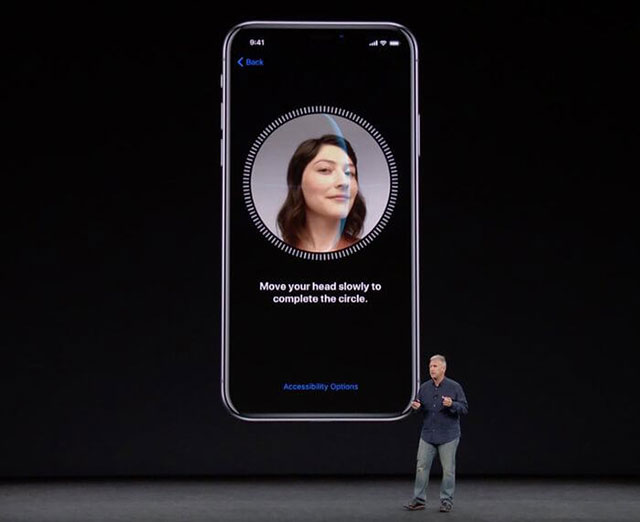How does Apple's Face ID work?
Apple's Face ID technology is only available on its iPhone X, replacing Touch ID to unlock the phone by recognizing the face. This poses a concern for those who are familiar with the speed and reliability that Touch ID offers, given that face recognition technology has failed. Although the technology used for Face ID is not new, Apple claims that it has been exploited better than ever.
How does Face ID work?
Face ID uses Apple's TrueDepth Camera. This camera scans the face and creates a depth map with more than 30,000 points. iPhone X uses these points and creates a mathematical model of the face, then stores it. In the following times, when the camera scans the face again, it will compare with the previous result and if it looks like it will unlock the device.
Face ID will detect when users look directly at the phone. If not, it will continue to lock. This avoids unlocking even if you don't want it when the device is near the user.
What about sunglasses, beards and shadows?
Infrared rays that Face ID uses normal human eyes cannot see but its function as well as normal light. Because the wavelength is lower than normal light, it will be easier to shine through objects, including sunglasses that block UV light and visible light. This type of light has a higher wavelength in the visible light spectrum. So most sunglasses allow infrared rays to pass through, allowing the Face ID to catch the eye even if you wear sunglasses.

Not new, but the technology Apple uses is the best
The iPhone X A11 Bionic chip has machine learning support, allowing Face ID to learn and remember changes. If you grow beard, cut hair or wear glasses, Face ID will remember the changes. It will have to look at how it actually works but if it is as Apple says it will be a major advance in the use of face recognition technology.
Infrared light allows Face ID to work even in the dark. The camera itself provides light source in the form of infrared rays, so no other external light source is needed. It also has a Flood Illuminator (a form of infrared flash) to balance the light on the face. Because the human eye is not visible, there will be no blinding flash light. Overall, even in the dark, iPhone X can still identify your face.
Is Face ID safe?
According to Apple, Face ID avoids phishing attacks that make other face-unlocking systems unsafe. That's because it uses an infrared camera that is sensitive to depth. An attacker cannot trick a camera with a photo. Even 3-dimensional masks cannot.
Although the method to avoid scams has not been announced yet, infrared light can penetrate the skin, allowing TrueDepth Camera to scan under the skin, making masks or images difficult to imitate. It is also possible that many pixels make it more difficult to create masks to trick.

Mr. Craig Federighi introduced Face ID at the iPhone X launch event
Like the Touch ID fingerprint, the face math model will be in the iPhone X's Secure Enclave. They are encrypted and other applications or OS cannot access it. The detected face is only on the device and is not stored on Apple's server or in sync with iCloud. So far, Secure Enclave has not been hacked.
Does Face ID replace Touch ID?
According to Apple, Face ID's error rate is 1 in 1,000,000. It means that Face ID will be unlocked wrong 1 in 1 billion times. Touch ID has an error rate of 1 out of 50,000, making Face ID safer. Like Touch ID, Face ID can authenticate Apple Pay. Does this mean that Face ID will replace Touch ID? If it can be as easy and reliable as Apple says it is possible.
See more:
The future of the iPhone depends on how you think Face ID
You should read it
- FaceID is easily bypassed with just plain tape and eyeglasses
- How to reset Face ID on iPhone X
- How to set Face ID on iPhone X
- The Touch ID and Face ID do not make you safer, why?
- What is Face ID? How to use it?
- 4 ways to improve Face ID stability
- The future of the iPhone depends on how you think Face ID
- How did Bkav announce the details of the Face ID on the iPhone X?
- Hackers can bypass the Face ID face with just a pair of black adhesive tape
- What will your face actually look like when you look through Face ID?
- Apple suggests how to prevent the thief from unlocking the iPhone X with your face
- How to predict your child's face in the future
May be interested

Don't believe when someone tells you the value of Bitcoin

Forget what your school says, research at MIT proves that Wikipedia is a source of scientific citation

Instagram displayed Follows You to know who followed you

Google acquired part of HTC's mobile segment for $ 1.1 billion

Do you believe that just one click can disable iOS 11 and turn iPhone 8 into a brick

Samsung awards up to 200,000 USD for those who find its smartphone bugs






 How many red apples should you eat a day?
How many red apples should you eat a day? 5 great benefits from apples you may not know
5 great benefits from apples you may not know How to order iPhone X
How to order iPhone X Meaning of names of different apples in the world
Meaning of names of different apples in the world What is Face ID? How to use it?
What is Face ID? How to use it? Things to note when eating apples
Things to note when eating apples